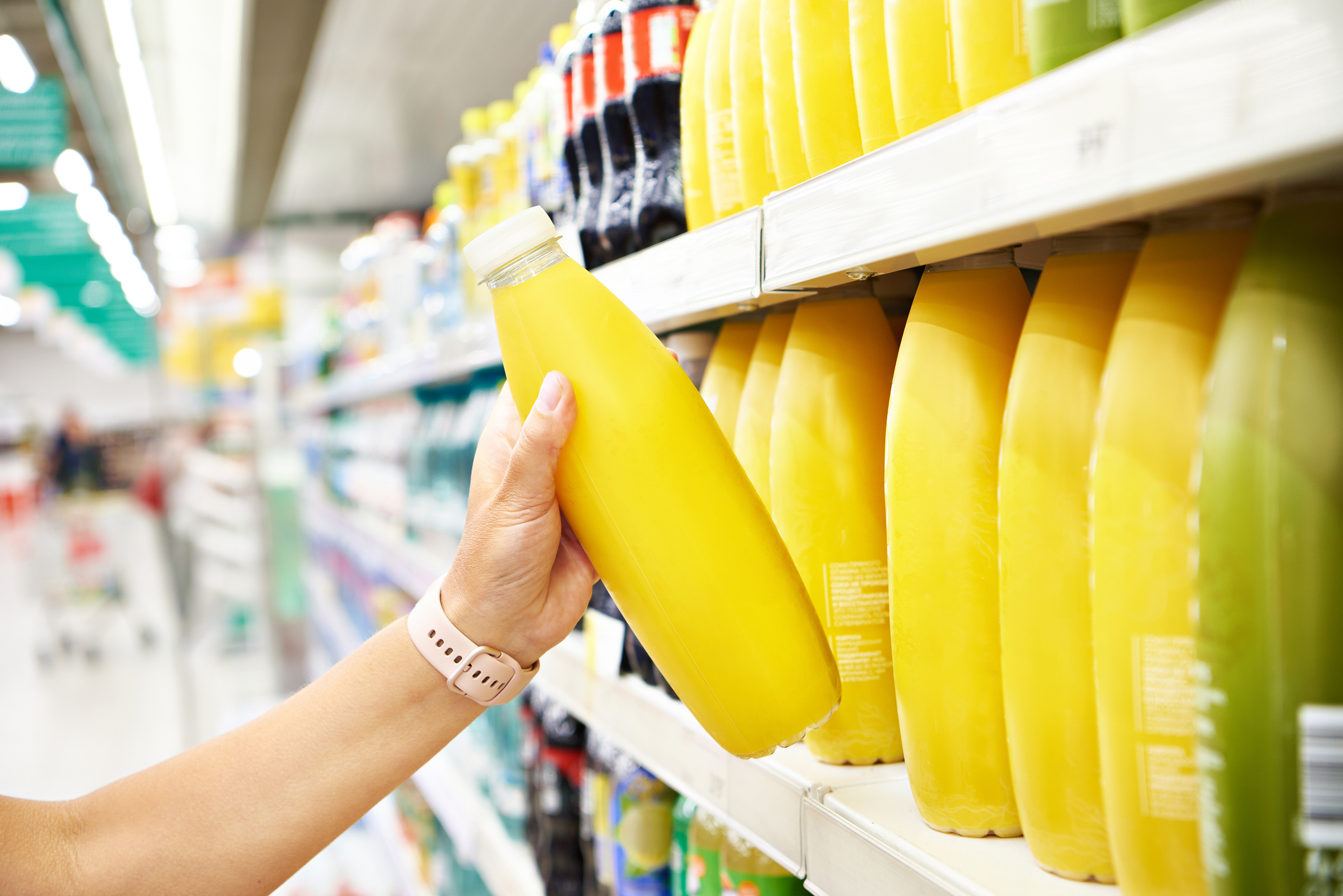Get Easy Health Digest™ in your inbox and don’t miss a thing when you subscribe today. Plus, get the free bonus report, Mother Nature’s Tips, Tricks and Remedies for Cholesterol, Blood Pressure & Blood Sugar as my way of saying welcome to the community!
Health store juices and smoothies a bunch of hype?

There’s a lot of hype about the health benefits of cold-pressed juices. Pretty much every health store is selling them but the truth is they’re not really that good for you. They’re also expensive, environmentally wasteful, and can actually be counter to a healthy lifestyle.
So the next time you consider forking out $10-$15 for a cold-pressed juice at one of those whole food stores — remember the following:
Juicing eliminates all the beneficial fiber
You know all that fibrous by-product of juicing that you throw in the trash? Well, that’s all the natural fiber once the juice is extracted.
We all need at least 30 grams or more of fiber daily to keep our intestinal tract working optimally, help eliminate cholesterol, support healthy levels of blood glucose, and prevent energy dips. Fiber actually counteracts the glycemic (sugar) spike that you get from eating the vegetable or fruit in its natural form. When you juice, the juicer separates the fiber from the juice. You are basically just consuming green sugar in a form that is going straight into the bloodstream. It’s no different than having a Coke, as far as sugar content.
Also, fiber makes you feel full — which helps with weight loss. Another reason you want to keep all that fiber in tack!
Juices (and smoothies) are mainly expensive sugar
It’s a juice! It’s green! And it’s sold in health stores! So it must be healthy right? Well, as I stated above, most of these drinks are deceptively high in sugars, with some providing nearly as much or more than you’ll find in soft drinks.
For example, Jamba Juice offers six unique flavors, all organic but packed with sugar. One 12-ounce serving of Organic Mango Limeade, for example, provides 37 grams of sugar, while Organic Tropical Greens comes in at 35 grams. (A 12-ounce can of Coke contains 39 grams of sugar.) Smoothies by the same manufacturer contain enough sugar and calories to be a bona fide health hazard. One 16-ounce Banana Berry Smoothie, for example, kicks in with 59 grams of sugar and 280 calories. Their Aloha Pineapple Smoothie kills with 67 grams of sugar and 310 calories for 16 ounces.
Ok, they are smoothies, but what about fresh juices?
Green Grove by Evolution Fresh, which is made from kale, spinach, oranges, spirulina, and seven other fruits and veggies, packs 36 grams of sugar into each 11-ounce serving. Sunshine State (contains orange, grapefruit, ginger, cayenne) by Paleta, contains 22 grams of sugar per 12 ounces. Dr. Earth Raw Juice Blend contains 21 grams of sugar, zero fiber, but at least it provides 330 percent % Daily Value of vitamin A (but… see below). A 16oz mixed fruit and vegetable juice like you would order at Whole Foods (containing beets, carrots, kale, cucumbers, apples, spinach, and celery) packs about 400 calories and over 50 grams of sugar. The price of these “cold-pressed” bottled juices is about $10 per bottle and up. That’s a lot to pay for sugar.
Juicing can prevent absorption of essential vitamins
On the surface, The Romanian, a green juice made from romaine lettuce, turmeric, celery, and green chard, states that each serving provides half of your daily requirement for vitamin A. But most people are unaware that since vitamin A is fat soluble, it needs to be consumed along with fat if you want to absorb the vitamin efficiently.
Yet The Romanian has 0 grams of fat. Another example is Dr. Earth Raw Juice Blend that provides a huge 330 percent of %Daily Value for vitamin A, yet only 1.5 grams of total fat.
Whether you eat your salad or drink it, you need fat grams (more than 6 grams according to an American Journal of Clinical Nutrition report) to facilitate absorption of fat-soluble vitamins. So you can’t rely on the %Daily Value claims as these depend on a specific nutritional environment to facilitate absorption that doesn’t exist when drinking the raw juice alone. See more on this below.
Commercial juices aren’t eco-friendly
Don’t think you’re benefiting the planet as well as your body when downing a cold-pressed juice. First of all, it takes about two to four pounds of fruit and vegetables to make a single 16-ounce serving of juice. All of this produce needs land, nutrients (organic or conventional fertilizers), pest management, labor to harvest, water, storage, and transportation. Sure, this has to happen anyway — but all of this just for a bottle of green juice that you down in 30 seconds?
It’s one thing to exert all of these efforts to produce two pounds of apples, which you can enjoy for days and reap all the nutrients and fiber from them. It’s quite another to take those same two pounds of apples, juice them down to a few ounces that you have to drink in less than 20 to 30 minutes or risk losing valuable nutrients, and toss away the fibrous pulp to boot. It just seems wasteful to me.
Consider this environmental impact as well: Once the fruits and veggies are pressed, the juice is exposed to tremendous energy-sucking and polluting pressure and cooling, then typically packaged in a plastic bottle (which may be BPA-free, but the alternative to BPA is just as harmful).
So how is all this waste good for the environment?
Their shelf life is questionable
The extreme pressure applied to juices to make them earn the name “cold-pressed” is supposed to make any pathogens inactive and also make the juice last for several weeks on the shelf as compared with fresh juice, which has about a two-day shelf life. The pressure technique is called high pressure processing (HPP), and according to a recent article on Daily Burn, “HPP neutralizes molecules that cause juice to spoil faster. This allows HPP-treated juice to last up to 45 days, roughly nine times longer than a freshly made cold-pressed juice.” This technique now allows cold-pressed juice producers to expand their market — mainly to retail outlets.
But do you really want a so-called “fresh juice” that has been sitting on the shelf for 45 days? I personally don’t trust the “sell by” or “use by” dates on cold-pressed juices. Yesterday I went to sample a coconut juice from Shakti out of a fridge at my gym. It was rancid. I tried another one as they both had “use by” dates that were about 2 weeks away. It was also rancid – and bubbled over when I opened it like some crazy science experiment. On top of all that, they both smelled like a petri dish.
Whole Foods also now has cold-pressed juice “dispensers” available in stores. To me, it just doesn’t seem right or consistent with the whole philosophy of juicing in the first place. The fact that juice is now available out of a dispenser just seems wrong — and more evidence of a large corporation trying to milk the benefits from an ill-perceived health benefit of which the general public has limited understanding.
You lose antioxidants and other nutrients quickly
When fruits and vegetables are juiced, the cell walls are broken, which in turn activates the antioxidants, vitamins, minerals, and enzymes in the produce. Depending on which items are in your juice, the amounts of available antioxidants and other nutrients will vary. One thing is certain: Most of these nutrients are susceptible to oxygen exposure and thus oxidation, which reduces the nutrient value in the fruits and veggies. Unlike an apple that you cut and expose a surface to air and oxidation, juices are even more vulnerable to this process because all of the fruits and vegetables juiced are exposed. The essential nutrients in juice begin to deteriorate and are nearly entirely gone within 20 minutes. Another thing to remember, as I mentioned before, is the unavailability of fat-soluble vitamins such as A, D, E, and K, which need fat to be absorbed. Cold-pressed juices typically do not contain the fats necessary for this to happen.
So if you are hoping to get your antioxidants and other nutrients from juices, steer clear of cold-pressed juices and make your own juices at home (see how to in my post next week) and drink them immediately. Better yet, stick to the “real” thing — whole, organic fruits and vegetables — and get all the nutrients plus fiber in every bite.












